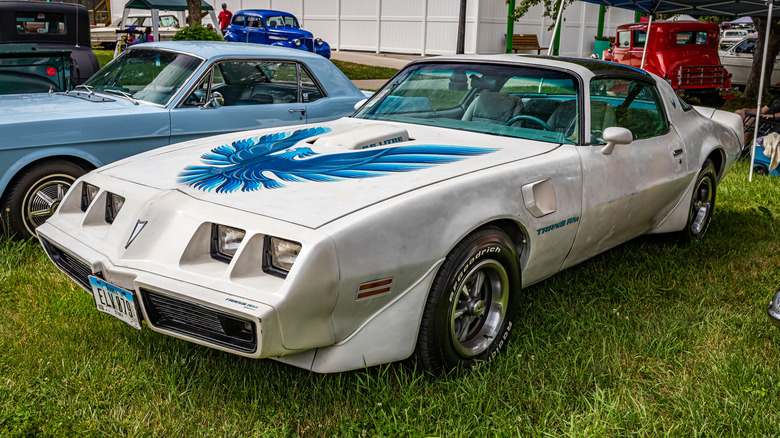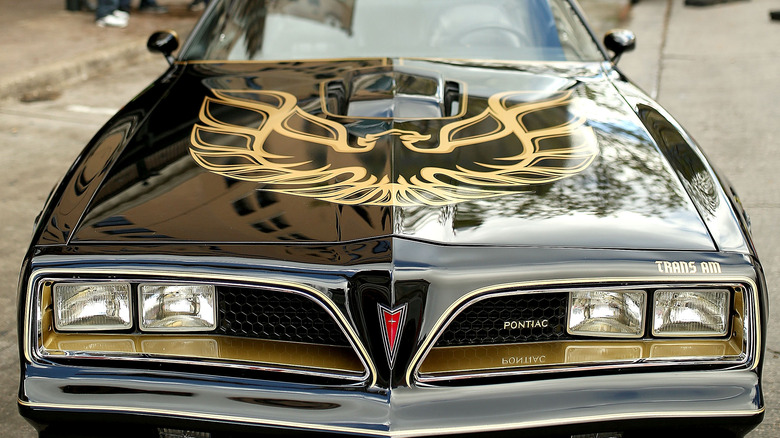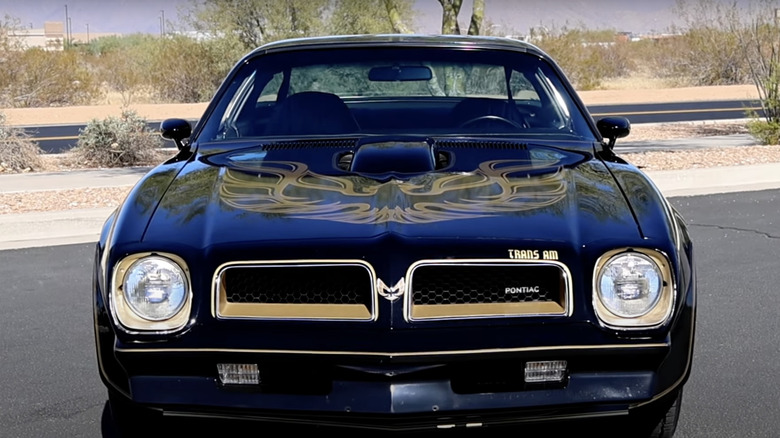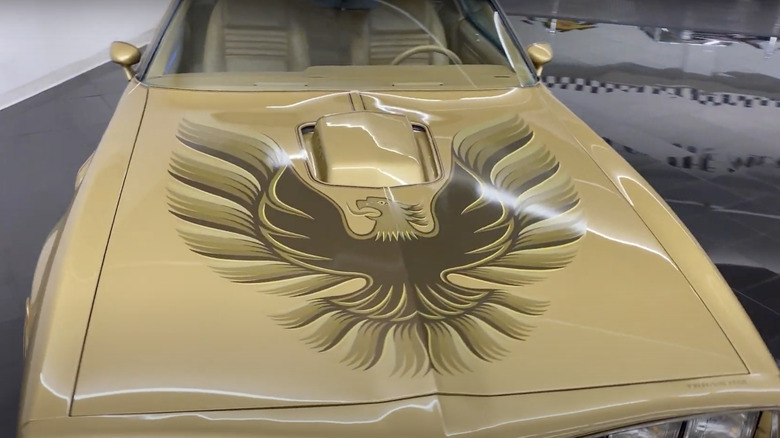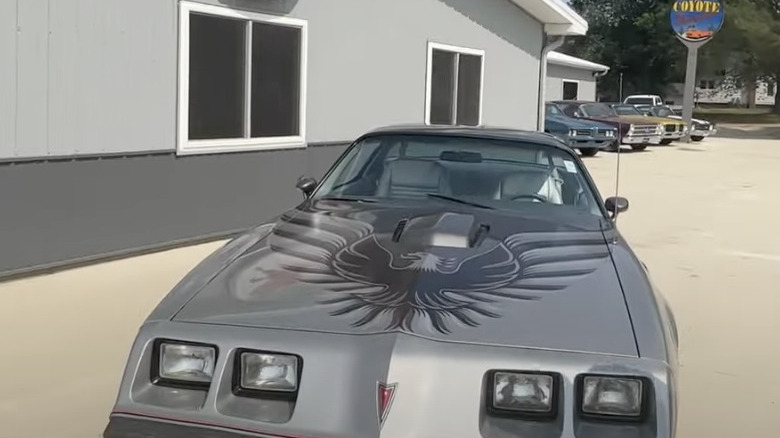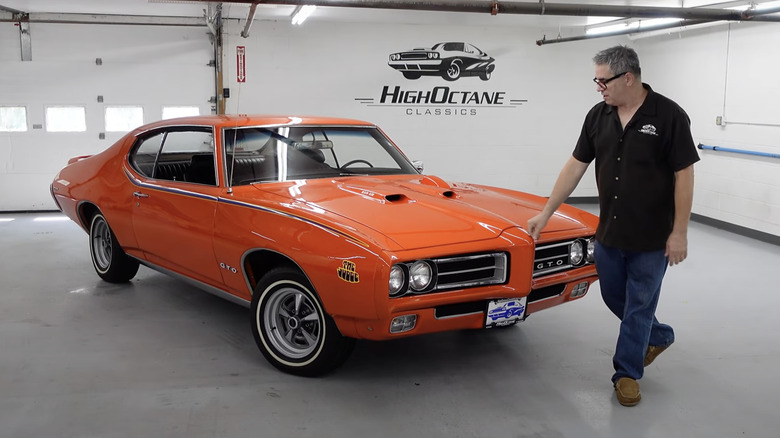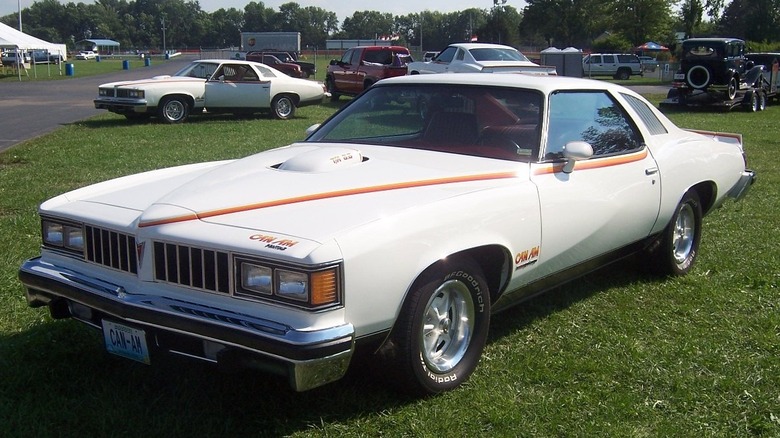6 Of The Coolest Graphics And Decals Pontiac Ever Put On Its Cars
General Motors launched the Pontiac brand in 1926, naming its new division after the Ottawa chief and Detroit suburb where many of GM's facilities are located. Pontiac was a force to be reckoned with in the '60s and '70s, cranking out powerhouses like the Firebird and GTO along with some underappreciated muscle cars. The John DeLorean-designed legendary 1964 Pontiac GTO also cleared the road for other high-horsepower and lightweight cars like the Ford Mustang, which debuted later that year.
Pontiac didn't just make cars that could go fast; the division put careful emphasis on design, including the use of striking graphics and camera-friendly logos that landed Pontiacs starring roles in film and on television. Many of those appearances featured the Trans Am, like the 1977 film "Smokey and the Bandit" and the 1980s TV series "Knight Rider." Pontiac's Hollywood stardom and eye-catching decorative touches couldn't save the division from overlap with other GM brands and the financial crisis of the early 21st century, though, and Pontiac flopped when GM dropped it in 2009.
Let's take a deep dive into Pontiac's history to find a handful of the coolest graphic design schemes the brand used on its cars over the past century.
1973 Trans Am hood logo
The Firebird and Pontiac Trans Am are often confused with one another due in no small part to the intimidating graphic that adorns the hood of both models. The Firebird was introduced alongside the 1967 Chevy Camaro. On initial release, it lacked the distinctive hood emblem that would become its signature. The giant logo, which some would derisively call "The Screaming Chicken," first appeared in 1973 along with the high-performance Trans Am variant of the Firebird. It was option code WW7, which added $55 to the cost of the Trans Am (about $400 in today's money).
Bill Porter, who led the Firebird design team, sketched the logo on a napkin in 1970 and enlisted a young designer, Norm Inouye, to bring it to fruition. In the 1979 book, "The Fabulous Firebird" (via Hagerty), Inouye said the decal wasn't universally welcomed at first. "Bill Mitchell walked through the paintshop one day and saw them working on it and didn't like it."
In the 1982 book "Firebird: America's Premiere Performance Car," (via Hagerty) Porter agreed. "He told me to get it off the car," he said. Mitchell mostly objected to the size of the emblem, as he had used a smaller winged bird logo on earlier models. However, designer John Schinella didn't give up on the larger version, pushing it forward after taking over from Porter in late 1971. After repeated tweaks, Pontiac head Jim McDonald relented. "John wants the bird standard on the Trans Am, but let's make it an option," Hagerty reported him saying. "We've got nothing to lose."
1976 50th Anniversary Trans Am
Porter later recalled Mitchell having a change of heart, and Schinella designed the black-and-gold color scheme that Pontiac put into use in 1976. That was the version used on the 1976 50th Anniversary Edition Trans Am, and the black-and-gold color scheme carried over to the 1977 model that Burt Reynolds drove in "Smokey and the Bandit."
The 1976 logo was 45.5 inches wide and 44.5 inches long. The Trans Am 50th Anniversary edition's bird logo was a bit larger than previous versions, and the celebratory model can be identified by the paint codes 19L and 19U on the cowl tag. The gold paint was likely a nod to the fact that this was the "golden" anniversary of the Pontiac brand, as the Trans Am was less than a decade old at that point.
The 50th Anniversary Trans Am lasted only one year, but its gold emblem lived on for two more. However, for 1977 and 1978, the gold-on-black paint scheme stayed on the Trans Am Special Edition's option sheet under codes Y81 and Y82.
Y88 Trans Am
In 1978, a Y88 Special Edition was also offered. This $1,263 package gave buyers a car painted in Solar Gold with a more intricate bird emblem on the hood. The Y88's logo was also larger than previous versions at 47 inches wide and 55 inches tall. It was also the first to face the passenger side of the car.
All 1979 Trans Ams were painted with this newly designed bird logo, except 10th Anniversary models (see below), which were decked out with an even larger version that branched out onto the front fenders.
In 1980 and 1981, naturally aspirated models got a similar logo that was 1 inch wider than the 1979 version, and turbocharged Trans Ams were given a bird with two layers of feathers to wrap around the hood bulge. The logo also appeared on 1980 Indy Hauler pickups and the 1981 Daytona 500 pace car, but the truck's bird was smaller and flipped around to face the driver's side again. When the Trans Am was redesigned in 1985, the turbo and hood bulge were gone and the bird was shrunk to 38 inches wide and 41 inches tall. It was also flipped again to face the passenger side. This model was listed as option code DX1 at a price of $95 (a little less than $300 today). Although 1987 was the last year for the factory-available logo, you can still purchase aftermarket versions for your classic Trans Am.
Silver Anniversary Trans Am
The 10th anniversary "Silver Edition" 1979 Trans Am deserves a spot on this list not just for the wider emblem that took the bird's wings past the side edges of the hood, but for the added design touches Pontiac used to mark the occasion. The black and red outlines of the logo stood out on the silver canvas of the hood, and the wings extended nearly to the side-view mirrors. The car got special wheels and anniversary badges, as well as narrow red and black stripes accenting the door sills, rear spoiler, and bumpers.
Of the 7,500 Silver Edition Trans Ams built, fewer than 2,000 had the T/A 6.6-liter (400-cubic-inch) engine hiding under the bird logo, while the rest got Oldsmobile's 403-inch V8 (via Hemmings). The logo must be seen up close to be truly appreciated, with its delicate red accents tracing the contours of the wings and details on the head and beak.
1969 GTO Judge
Pontiac didn't keep all its graphic artists working on the Trans Am's giant hood emblems. For the 1969 GTO Judge, a few subtle touches were applied to distinguish it from the standard GTO, which had shed much of its chrome the year before. GTO designer John DeLorean was a fan of the variety show "Rowan and Martin's Laugh-In," which often featured a segment starring Sammy Davis Jr., who co-opted his character's catchphrase, "Here Comes the Judge," from a 1968 song by comedian Pigmeat Markham. The special edition of the GTO was originally going to be called the ET, for "elapsed time," but DeLorean intervened.
The GTO Judge had a narrow tapered stripe that followed the contours of the front fenders and doors before ending near the B-pillars. "The Judge" was emblazoned in a '60s-style font just behind the headlights and on the rear spoiler, and Ram Air III-equipped versions had small letters identifying them as such on the sides of the hood scoops. According to Hemmings, the first 2,000 Judge GTOs off the line were all painted Carousel Red, but later buyers could choose from a range of colors.
Can Am
Another subtle but striking muscle car graphics package was that of the Can Am, a car Pontiac only made for half of 1977. It was built on the LeMans platform but got a hood scoop, rear spoiler, and louvered rear quarter windows. It was named after the Canadian-American racing series and had orange and rust stripes running from the upper edge of the doors to a "V" just above the Pontiac arrowhead logo at the center of the grille. Model identifier badges in a gradient version of the same color scheme sat above the headlights, behind the front wheels, and on the trunk lid.
According to Auto Evolution, the mold used to make the fiberglass rear spoiler broke during the first few months of production. Whether this is true or Pontiac execs thought the Can Am was taking away too many sales from the Grand Prix, the company used this opportunity to ax the Can Am mid-year. Top Speed reports that exactly 1,377 Can Ams were made, making them a rarity on the secondhand market today.
[Featured image by TropicDave via Wikimedia Commons|Cropped and scaled|CC-By 3.0]
